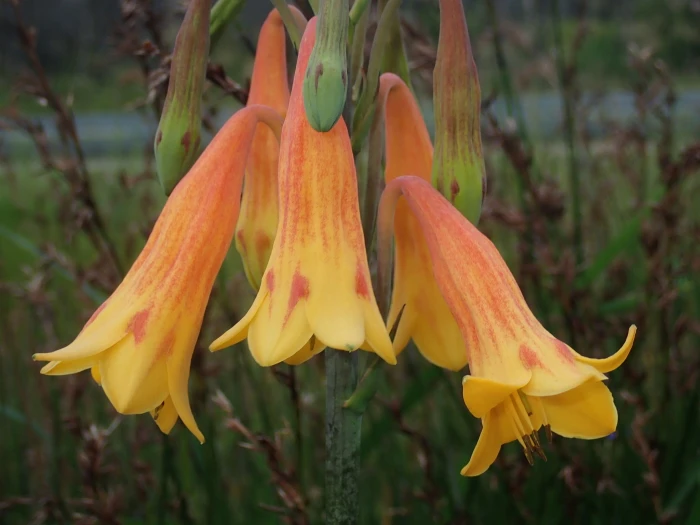Christmas Bells
(Blandfordia grandiflora)
Christmas Bells (Blandfordia grandiflora)
/
/

Thomas Mesaglio
CC BY 4.0
Image By:
Thomas Mesaglio
Recorded By:
Copyright:
CC BY 4.0
Copyright Notice:
Photo by: Thomas Mesaglio | License Type: CC BY 4.0 | License URL: http://creativecommons.org/licenses/by/4.0/ | Rights Holder: Thomas Mesaglio | Publisher: iNaturalist | Date Created: 2021-01-01T14:14:59-08:00 |

























Estimated Native Range
Climate Requirements for Greenville, Mississippi
| This Plant | Your Site | Plant Suitability for Your Location | ||
|---|---|---|---|---|
| • Precipitation | 31" - 71" | 54" | Aquatic | Aquatic |
| • High Temp. | 72°F - 86°F | 93°F | Your summers may be too hot for this plant. | Too hot |
| • Low Temp. | 33°F - 55°F | 33°F | Your winter temperatures are normal for this plant | Excellent |
This plant should grow very well at your location but requires an aquatic environment.
Summary
Blandfordia grandiflora, commonly known as Christmas bells, is a tufted perennial herb endemic to coastal heathlands and wet, open forests of eastern Australia, particularly between Sydney in New South Wales and Fraser Island in Queensland. It can reach up to 31 inches in height and features narrow, linear, channelled leaves. The plant is notable for its 2-20 large, drooping bell-shaped flowers, which are typically red with yellow tips, although they can also be entirely yellow. These showy flowers bloom from late spring to early summer, adding vibrant color to the garden. In its native habitat, Blandfordia grandiflora thrives in damp, sandy soils and is adapted to the acidic conditions of wet coastal heaths.
Christmas bells are appreciated for their unique and colorful flowers, which make them an excellent choice for ornamental gardens, borders, and as cut flowers for festive arrangements. They require well-drained, acidic soils and consistent moisture to mimic their natural habitat. While they prefer full sun, they can tolerate light shade. Gardeners should be aware that Blandfordia grandiflora can be sensitive to root disturbance, so it is best to avoid transplanting them once established. They are relatively low maintenance, but it is important to protect them from snails and slugs, which can damage the foliage and flowers.CC BY-SA 4.0
Christmas bells are appreciated for their unique and colorful flowers, which make them an excellent choice for ornamental gardens, borders, and as cut flowers for festive arrangements. They require well-drained, acidic soils and consistent moisture to mimic their natural habitat. While they prefer full sun, they can tolerate light shade. Gardeners should be aware that Blandfordia grandiflora can be sensitive to root disturbance, so it is best to avoid transplanting them once established. They are relatively low maintenance, but it is important to protect them from snails and slugs, which can damage the foliage and flowers.CC BY-SA 4.0
Plant Description
- Plant Type: Herb
- Height: 1.5-2.5 feet
- Width: 1-2 feet
- Growth Rate: Slow
- Flower Color: Red
- Flowering Season: Summer
- Leaf Retention: Evergreen
Growth Requirements
- Sun: Full Sun, Part Shade
- Water: Medium
- Drainage: Medium
Common Uses
Border Plant, Butterfly Garden, Low Maintenance, Potted Plant
Natural Habitat
Coastal heathlands and wet, open forests
Other Names
Common Names: New South Wales Christmas Bell
Scientific Names: Blandfordia grandiflora, Blandfordia aurea, Blandfordia flammea, Blandfordia flammea var. princeps, Blandfordia grandiflora var. intermedia, Blandfordia intermedia, Blandfordia princeps, Blandfordia speciosa
GBIF Accepted Name: Blandfordia grandiflora